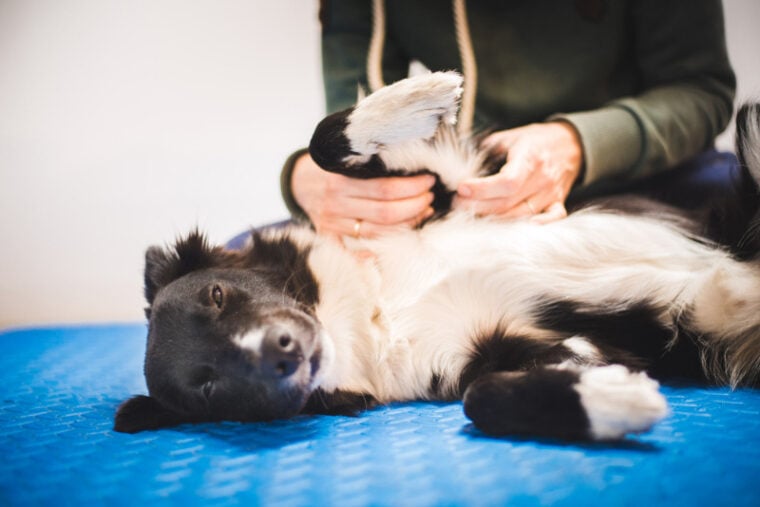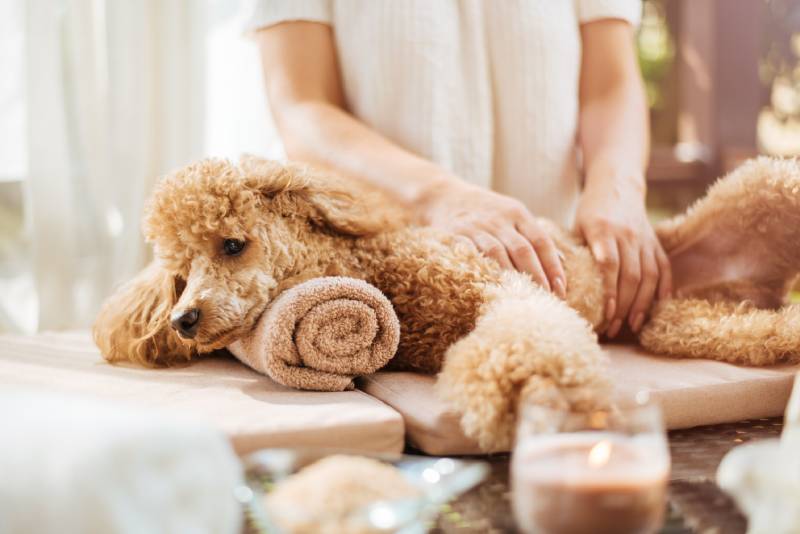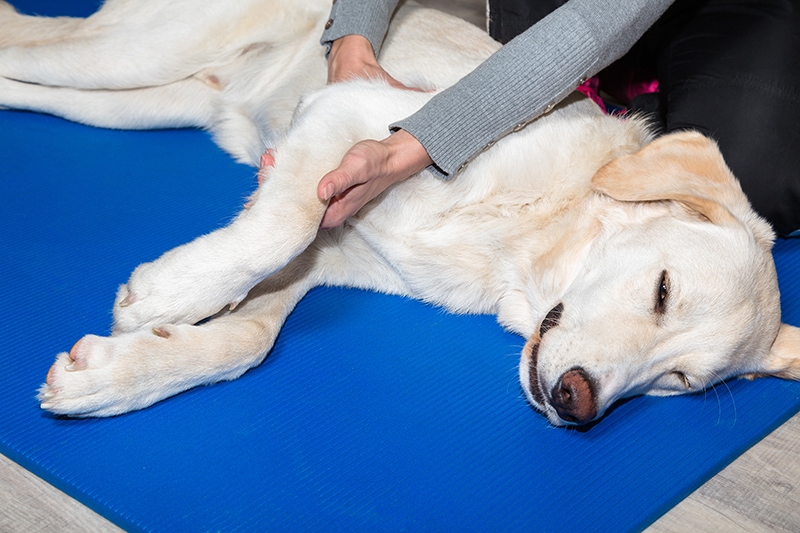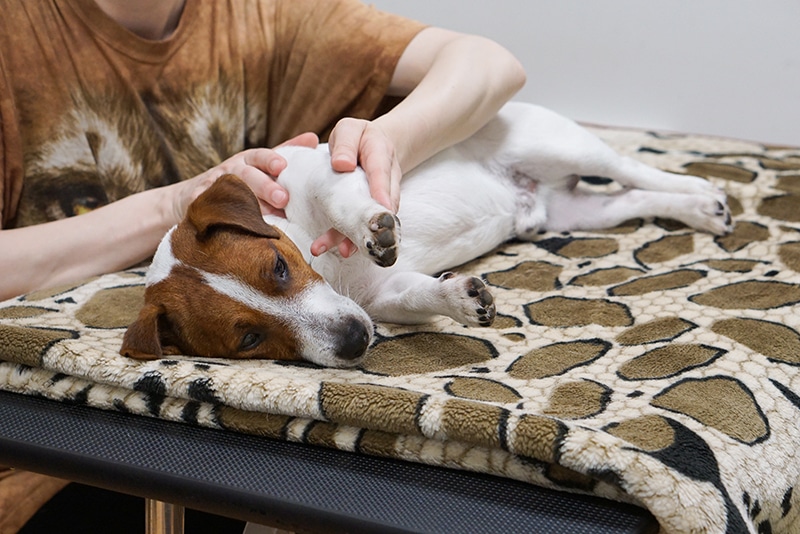
There’s nothing quite like a nice, relaxing massage to help de-stress and ease sore muscles. We aren’t the only ones that can reap the benefits of massage though, some of our animal friends can soak up the bliss too – especially our canine family members.
Not only can dogs benefit from massage but it also doubles for some much-needed bonding time, so why not learn how to get the job done right? We do recommend talking to your veterinarian before getting started since they are familiar with your dog’s unique medical history and are the best resource for health advice. Once you have the all-clear, you can follow these easy steps to provide the best doggy massage possible.
The 5 Steps on How to Massage a Dog
1. Find a Quiet Area and Understand the Motions

First and foremost, you want to find a quiet area that is free from distractions so that you can have the most relaxing environment possible. Make sure to have calm energy so that you can help your dog to wind down and feel calm as well.
Not all dogs will be comfortable with a massage, so do not attempt this if your dog is nervous or fearful. This happens most frequently in dogs that have suffered a history of abuse or neglect, but it could also make certain dogs anxious in general.
Use this time to bond with your dog and be sure to check over their body to see if you notice any areas of inflammation, sensitivity, or signs of pain. If you do notice swelling or any signs of pain or discomfort, we recommend ending the massage and contacting your veterinarian before moving forward.
Start off by petting them gently on the head place your palms flat and press against the skin lightly. You will slowly move your hands using long, sweeping motions and you work your way down the body.
2. Start at the Head and Work Your Way Down the Back
Using the technique above, start from the head and neck area and slowly work your way down the body. As you proceed, you can gently increase pressure if your dog is responding well to the massage.
Avoid pressing directly down on any bones or joints and avoid touching any areas that make your dog uncomfortable. Stroke up and down the back of the head, down to the neck, and then down each side of the spine using a comfortable amount of pressure.
Dogs are often big fans of back massages, as they promote calm and relaxation, especially when rubbed at the base of the tail.
3. Focus on the Forehead

If your dog is comfortable and you’d like to put some focus on the head, you can gently massage the head by starting at the top of the nose then running your thumb up the nose and over the head, and then repeating this back and forth, gently and slowly.
There is a well-known acupressure point at the top of the nose, so this can be very calming and feel wonderful for your dog. Make sure to watch their body language and do not proceed if your dog pulls away or shows any signs of being uncomfortable with the process.
4. Rub the Ears
There may be some exceptions to the rule, but most dogs love a good old-fashioned ear rub, and according to experts, massaging the ears can have a therapeutic effect. For an ear massage, start by placing your thumb on the inside of the ear at the base of the flap with your index finger on the outside.
Slowly stroke outwards toward the end of the ear using gentle pressure and pull gently when you reach the end of the ear. Refrain from using heavy pressure or pulling too hard and repeat as many times as you and your dog are comfortable.
5. Move to the Legs

It’s common for dogs to suffer from arthritis and mobility issues, especially during their senior years. Chronic pain often affects the legs and if your dog has issues in these areas, massage can provide some much-needed relief.
We strongly recommend that massages that are specifically for pain relief and pain management for conditions such as arthritis be done by a professional or under the direct supervision of a veterinarian. There are certain conditions where massage could exacerbate the pain, and your veterinarian will have done the proper diagnostics to ensure the dog is a good candidate for massage.
If you have gotten the all-clear from your dog’s veterinarian to proceed with a massage at home, a leg and glute massage can help with muscle tension and promote flexibility.
You will start by using gentle pressure and pressing both of your thumbs into the thigh or glute muscle and then make a backward “c.” You will then slowly work your way across the entire muscle, making clockwise circles with your thumbs.
The Benefits of Massaging Your Dog
Reduced Anxiety
The gentle, hands-on contact of a massage can promote calm and relieve anxiety. Not only does it help your dog bond with you and form a closer connection, but a massage can help lower the heart rate, calm the central nervous system, and promote the release of those feel-good hormones.
This can be incredibly beneficial during times of high anxiety such as fireworks, thunder, or any other kind of situation that causes your dog to feel anxious and stressed.
Pain Relief
The friction from the rubbing and kneading during a massage encourages blood flow and increases circulation to that area of the body. Since both oxygen and nutrients are carried within the blood flow, this increase in circulation can help provide relief to any areas of pain or soreness.

Mobility Support
Massaging relaxes the muscles and stimulates the flow of blood and oxygen throughout the body. This promotes flexibility, increases range of motion, and provides mobility support for the targeted areas.
Increased Recovery
We already know that massage increases circulation, meaning it also increases the blood supply to the muscle’s joints and nerves. This is great both before and after periods of intense activity and can help prevent injury or soreness following exercise.
Conclusion
Not only can a massage benefit your dog both mentally and physically, but it’s also a great way for the two of you to spend some one-on-one time together bonding. Remember to get in touch with your veterinarian to ensure massaging will be beneficial for your dog’s unique circumstances. Following the steps and techniques above can ensure you are getting the job done right so that your beloved dog can get the most out of your massage.
Featured Image Credit: Jus_Ol, Shutterstock








